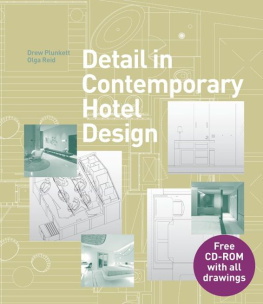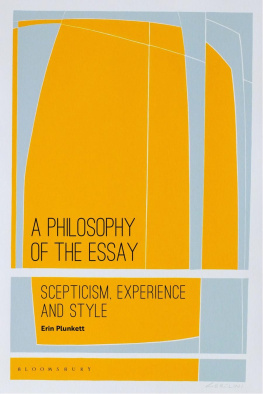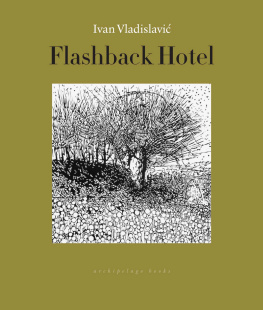Drew Plunkett - Detail in contemporary hotel design
Here you can read online Drew Plunkett - Detail in contemporary hotel design full text of the book (entire story) in english for free. Download pdf and epub, get meaning, cover and reviews about this ebook. year: 2013, publisher: Laurence King, genre: Home and family. Description of the work, (preface) as well as reviews are available. Best literature library LitArk.com created for fans of good reading and offers a wide selection of genres:
Romance novel
Science fiction
Adventure
Detective
Science
History
Home and family
Prose
Art
Politics
Computer
Non-fiction
Religion
Business
Children
Humor
Choose a favorite category and find really read worthwhile books. Enjoy immersion in the world of imagination, feel the emotions of the characters or learn something new for yourself, make an fascinating discovery.
- Book:Detail in contemporary hotel design
- Author:
- Publisher:Laurence King
- Genre:
- Year:2013
- Rating:4 / 5
- Favourites:Add to favourites
- Your mark:
- 80
- 1
- 2
- 3
- 4
- 5
Detail in contemporary hotel design: summary, description and annotation
We offer to read an annotation, description, summary or preface (depends on what the author of the book "Detail in contemporary hotel design" wrote himself). If you haven't found the necessary information about the book — write in the comments, we will try to find it.
Detail in contemporary hotel design — read online for free the complete book (whole text) full work
Below is the text of the book, divided by pages. System saving the place of the last page read, allows you to conveniently read the book "Detail in contemporary hotel design" online for free, without having to search again every time where you left off. Put a bookmark, and you can go to the page where you finished reading at any time.
Font size:
Interval:
Bookmark:
DETAIL IN CONTEMPORARY HOTEL DESIGN Published in 2013 by Laurence King Publishing Ltd 361373 City Road London EC1V 1LR email: www.laurenceking.com Copyright Text 2013 Drew Plunkett All rights reserved. No part of this publication may be reproduced or transmitted in any form or by any means, electronic or mechanical, including photocopy, recording, or any information storage or retrieval system, without permission in writing from the publisher. A catalogue record for this book is available from the British Library ISBN: 978 1 78067 285 4 Designed by Olga Reid Project Editor: Gaynor Sermon Cover design by Hamish Muir Printed in China DETAIL IN CONTEMPORARY HOTEL DESIGNDREW PLUNKETT AND OLGA REIDLAURENCE KING PUBLISHING CONTENTS INTRODUCTION Most interiors support a single, well-defined, function, but those in hotels must accommodate a diverse range of activities rest and refreshment, work and recreation each of which prompts a variation on the core aesthetic that binds the whole. None necessarily requires grand gestures but in the generous volumes of existing buildings that are increasingly being recycled as hotels and in the suites that perch on top of stacked floors of conventional bedrooms there are opportunities for more extravagant responses. Structural amendments may be necessary for the most ambitious interventions but interior construction is usually simple. Standard partition wall techniques will deal with the repetitive carcassing of bedroom floors and sprawling public spaces can be styled and shaped by the selection and deployment of furniture.
Published in 2013 by Laurence King Publishing Ltd 361373 City Road London EC1V 1LR email: www.laurenceking.com Copyright Text 2013 Drew Plunkett All rights reserved. No part of this publication may be reproduced or transmitted in any form or by any means, electronic or mechanical, including photocopy, recording, or any information storage or retrieval system, without permission in writing from the publisher. A catalogue record for this book is available from the British Library ISBN: 978 1 78067 285 4 Designed by Olga Reid Project Editor: Gaynor Sermon Cover design by Hamish Muir Printed in China DETAIL IN CONTEMPORARY HOTEL DESIGNDREW PLUNKETT AND OLGA REIDLAURENCE KING PUBLISHING CONTENTS INTRODUCTION Most interiors support a single, well-defined, function, but those in hotels must accommodate a diverse range of activities rest and refreshment, work and recreation each of which prompts a variation on the core aesthetic that binds the whole. None necessarily requires grand gestures but in the generous volumes of existing buildings that are increasingly being recycled as hotels and in the suites that perch on top of stacked floors of conventional bedrooms there are opportunities for more extravagant responses. Structural amendments may be necessary for the most ambitious interventions but interior construction is usually simple. Standard partition wall techniques will deal with the repetitive carcassing of bedroom floors and sprawling public spaces can be styled and shaped by the selection and deployment of furniture.
Public and communal spaces will normally aspire to the monumental but the activities they, and every other area, accommodate should provide what is, in essence, a heightened domesticity; the mechanics and comforts of home in an environment that transcends the familiar. In the beginning, the antecedents of hotels met the basic needs to eat and sleep of those travelling through necessity rather than for pleasure. As domestic interiors evolved so did provision for travellers and in the 19th century grand hotels emerged in the great cities and resorts to cater for the leisured and moneyed beneficiaries of industrialization, providing sumptuous environments for formal social rituals. Continuing innovations in means of travel and a filtering down of wealth exponentially increased the numbers and motivations of travellers. Modest interpretations of the grand model appeared at every large railway station and, as the numbers of travellers grew, variations emerged to suit varying pockets. In the second half of the 20th century the increasingly global hotel market was subsumed by chains, the Hiltons, Holiday Inns and more, that emerged to accommodate leisure and, increasingly, business travellers, who were assumed to want the reassurance of a consistent product.
This was determinedly insipid, with bland interiors behind modular elevations, both shaped by dour architectural theory and reinforced by business planning that was not yet convinced about the lucrative potential of more ambitious design. There were exceptions to the bland rule. Arne Jacobsens SAS hotel, 1956-60, in Copenhagen made a stylistic match between Modernist exterior and interior but new hotels generally offered a flavourless, diluted Modernism. Occasional exceptions operated outside the chains and owed more to their owners eccentricity than the singular voice of a designer. The stylistic about-face that followed the Post Modernist debate was marked in the hotel world by the arrival in New York, in 1988, of Philippe Starcks Royalton, an extraordinary aesthetic leap forward that was the antithesis of the mainstream aesthetic and demanded, and got, attention. Its exuberance and example were reinforced two years later in the Paramount, a less expensive option for a less affluent clientele, also designed by Starck, also in New York, and also for the Royaltons owner, Ian Schrager.
The two interiors presented a provocative template that was ecstatically received by enthusiasts for the new aesthetic that had become familiar in the interiors of shops, bars and restaurants. Schrager, who had created Studio 54, New Yorks most fashionably notorious nightclub, understood that market; a renegade client able and prepared to offer opportunity and support to a visionary designer. His collaboration with Starck established, with the objectivity of the balance sheet, that radical hotel interiors, which became destinations in their own right, were good for business. The Royalton and Paramount were the most high profile examples of the new wave but there were other designers who had found opportunities to innovate with progressive clients. A few years before Starck Andree Putman had created Morgans, also in New York and also for Schrager, with a more restrained, elegantly sumptuous but decidedly contemporary aesthetic. It has been credited with providing the template for boutique hotels.
Marie-Christine Dorner, created La Villa in Paris in 1988 and confirmed that there was something radical in the air in the field of hotel design. Innovative interiors, accommodated almost invariably in the shells of existing buildings, some of which had been hotels with flagging profit sheets, became tourist destinations themselves, replacing the splendour and pedigree of the grand hotels with a more inclusive flamboyance. The earliest iterations of the formula tended, perhaps inevitably, to be one-off developments, and were frequently small scale. The bland purpose-built corporate solution fell from favour, usurped by the characterful detail inherent in recycled shells. Some one-offs evolved into modest chains but their strategists recognized that if they were to continue to be successful their name had to guarantee that, while each location would offer the same standards of service, the interior would be unique, evocative of its location and fine tuned to its anticipated clientele. They subscribed to, and benefitted from, the cult of the chic brand.
Designer joined boutique as a generic label. The obsessive pursuit of the flamboyant and unique inevitably taxed creativity. Solutions, overwrought by less talented designers, became fatuous and frequently vulgar. An aesthetic escalation set in and some clients appointed a gaggle of designers for a single project. Some went further in the pursuit of attention and employed fashion designers and artists who had more name recognition than specialist interior designers and whose exuberance was not inhibited by an awareness of sound interior design principles. Neither formula guaranteed coherence, particularly when different designers tackled different public rooms.
Stylistic incongruities were less problematic in bedrooms but, since guests see only the interior of their own room, the menu of options, unless exploited as a marketing device, had little value. The visual language and eccentricites of the designer hotel have found their way into the cheaper chains, although gestures tend to be less bombastic, usually curbed by financial considerations rather than taste, but none the worse for that. The best examples show considered restraint and, if that is the result of tighter budgets, it also corresponds to changes in designers priorities. Reaction against extravagant use of materials and resource-intensive production is prompted by concern, reinforced by regulations, for sustainability, and that resonates with guests environmental sensibilities. Economic anxieties, particularly in the stalled economies of the West, have also encouraged more modest expectations. Highly tuned detailing of expensive materials is being replaced with something that appears simpler, if sometimes a little crude.
This is acceptable, however, because the outcome appears to wear an environmentally responsible heart on its sleeve. The re-use of existing buildings may offer ready-made visual detail but it may also be perceived as a conservation tactic and therefore as virtuous. Redundant industrial structures lend themselves particularly well to shabbychic conversions and an acceptance of dilapidation requires less painstaking restoration and less sumptuous furniture and fittings. Inevitably there are customers who favour conventional models, preferring a familiar package that flaunts neither extravagance nor expediency, but even they have learned to expect more than bed and breakfast. Competition, whether between chains or single units, has led to an escalation of ancillary provisions, conference rooms and business suites, swimming pools and spas. While the awards of the stars and rosettes indicating quality continue to be crucial in customers decision making, the inflexible provision of equipment and amenities necessary to earn grades is as likely to result in a surfeit of gadgets as it is to make a well considered bedroom.
Next pageFont size:
Interval:
Bookmark:
Similar books «Detail in contemporary hotel design»
Look at similar books to Detail in contemporary hotel design. We have selected literature similar in name and meaning in the hope of providing readers with more options to find new, interesting, not yet read works.
Discussion, reviews of the book Detail in contemporary hotel design and just readers' own opinions. Leave your comments, write what you think about the work, its meaning or the main characters. Specify what exactly you liked and what you didn't like, and why you think so.









